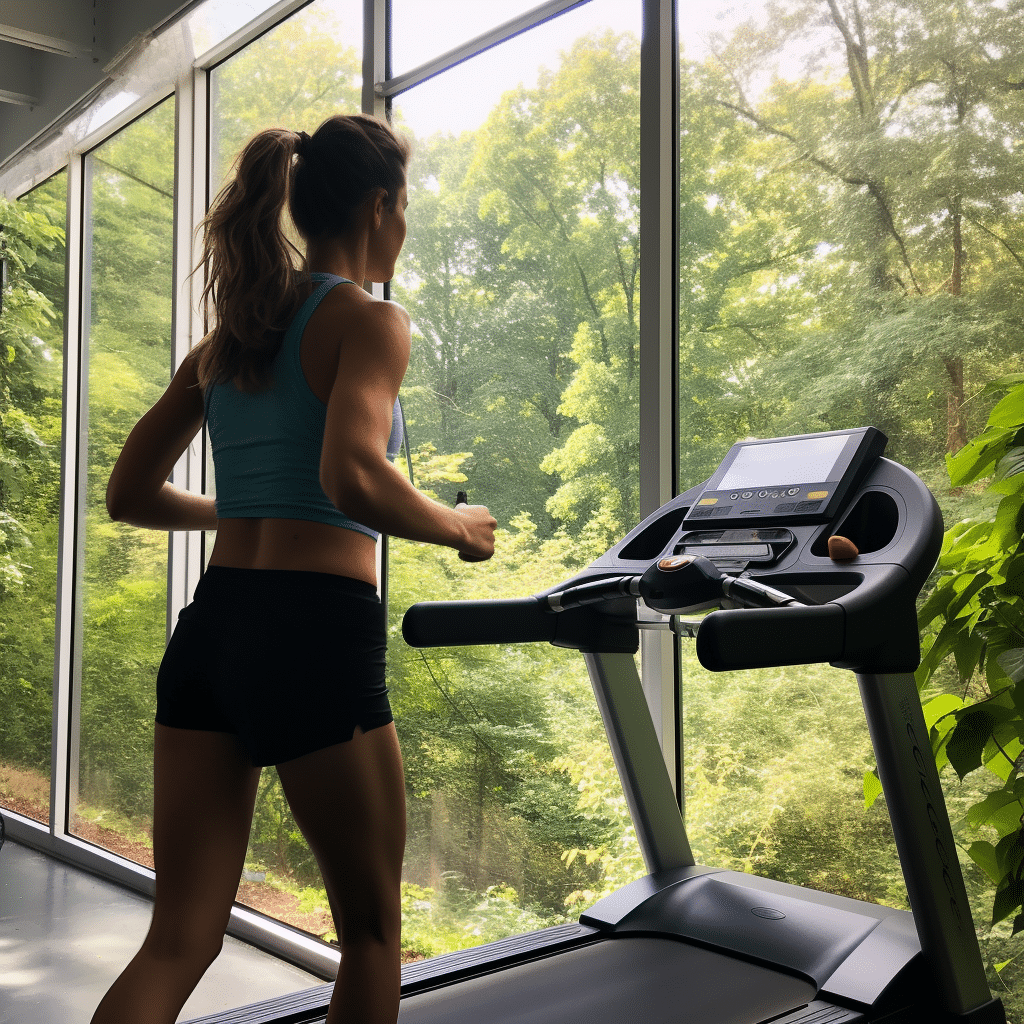Introduction
It’s popular for improving cardiovascular health, stress, and weight because it’s accessible to all fitness levels. Both indoor treadmill walking and outdoor walking have pros and cons. Treadmill walking is convenient, safe, and consistent. A treadmill’s flat, cushioned surface may be better for joints and certain health issues.
However, outdoor walking connects you to nature, fresh air, and varied terrain, making it fun and mentally stimulating. Outdoor challenges can strengthen stabilizing muscles and improve fitness. We’ll discuss the pros and cons of treadmill and outdoor walking to help you choose based on your fitness goals and preferences. Outdoor walking and treadmill walking have different benefits. Treadmill walking is ideal for those who prefer a controlled and predictable workout. A treadmill can be used regardless of weather, time, or safety, allowing people to stick to their routine.
The treadmill’s cushioned surface reduces joint impact, making it appealing to those with joint issues or those starting out in fitness. Outdoor walking is deeply rooted in nature and connects people to the outdoors. Outdoor walking is stimulating and mentally refreshing due to the changing seasons, fresh air, and variety of terrains, from urban streets to scenic trails.
Is it better to walk outside or inside on a treadmill?
Studies from 2013 and 2015 also found that walking in nature reduces stress and anxiety more than walking in urban settings. With this in mind, we can deduce that walking outside is better for your mental health than walking on the treadmill inside your home.
Mindfulness and Relaxation: Being in a natural outdoor environment can provide opportunities for mindfulness and relaxation. You can enjoy the sounds of nature, sights, and the feeling of being present in your surroundings. Walking outdoors engages your senses, allowing you to see, hear, and smell the world around you. This sensory stimulation can enhance the overall experience.
Creativity and Exploration: Outdoor walking allows you to explore new places and discover different walking routes, which can add an element of adventure and creativity to your routine. Depending on your location, outdoor environments can provide diverse terrain, including hills, trails, and soft surfaces, which can challenge your muscles in different ways.
Time Efficiency: Treadmill walking can be more time-efficient because you don’t need to spend time traveling to a specific outdoor location. Treadmills offer precise control over factors such as speed and incline, making it easier to adjust your workout to specific fitness goals.
Safety and Consistency: Treadmills provide a safe and controlled environment, reducing the risk of injuries or accidents due to uneven terrain, traffic, or weather conditions. Treadmills are accessible year-round, allowing you to maintain your walking routine even during extreme weather conditions.
What is a good speed to walk on a treadmill to lose weight?
If you’re walking for your health, a pace of about 3 miles per hour (or about 120 steps per minute) is about right. That’s a 20-minute mile. To walk for weight loss, you’ll have to pick up the pace to 4 miles per hour (or 135 steps per minute), a 15-minute mile.
Interval Training: Incorporating interval training into your treadmill workouts can be highly effective for weight loss. Alternating between periods of higher intensity (e.g., faster walking or running) and recovery (e.g., slower walking) can increase calorie burn and boost your metabolism.
Progressive Overload: As your fitness level improves, consider gradually increasing the intensity of your treadmill workouts. This can involve walking at a faster pace, increasing the incline, or extending the duration of your sessions.
Tracking Progress: Using a heart rate monitor or fitness tracker can help you monitor the intensity of your workouts. It’s also useful for keeping track of your calorie expenditure. Combining strength training with your treadmill workouts can help you build muscle, which can boost your metabolism and support long-term weight loss. Include exercises that target major muscle groups.
Variety: To prevent boredom and plateaus, vary your treadmill workouts. Incorporate different types of workouts, such as interval training, steady-state walks, and hill workouts. You can also use different pre-set treadmill programs if your machine offers them.
What is the most efficient way to walk on a treadmill?
Treadmill workouts to help you increase the burn | CNN
The 30-minute workout is simple: Set your treadmill to a 12% incline and the speed to 3 miles per hour, then go. An easier version geared toward beginners calls for the first 15 minutes at a 2.5% incline and the second 15 minutes at an 8.5% incline. “The 12-3-30 workout is a fantastic workout as well,” Bulay said.
Warm-Up and Cool Down: Always include a warm-up and cool-down in your treadmill workouts. Begin with a few minutes of walking at a slower pace to prepare your body for the workout. After the 12-3-30 routine, walk at a slower pace for a few minutes to help your heart rate return to normal.
Proper Form: Maintain good posture while walking on the treadmill. Keep your back straight, engage your core, and avoid holding onto the handrails unless necessary for balance. Holding onto the handrails can alter your posture and reduce the effectiveness of the workout. Stay well-hydrated during your workouts. Have a water bottle within reach and take sips as needed, especially if your treadmill workouts are longer or intense.
Progression: As your fitness improves, you can gradually increase the incline, speed, or duration of the 12-3-30 workout to continue challenging your body and making progress. While the 12-3-30 routine is effective, it’s essential to add variety to your treadmill workouts. Include different routines, such as interval training, tempo runs, and longer, slower-paced walks, to prevent boredom and plateaus.

Is a treadmill better for knees than outside?
Treadmills offer better shock absorption than pavement or roads, which means less stress on the ankles and knees, particularly if you’re wearing well-cushioned treadmill running shoes. And when you run at an incline on the treadmill, you build strength and endurance like you would running hills outside.
Shock Absorption: Treadmills have cushioned surfaces that absorb some of the impact when your feet strike the belt. This cushioning can reduce the stress on your joints, including your ankles and knees. Many modern treadmills are designed with shock-absorbing systems to provide a more forgiving surface for your joints.
Consistency: Treadmill surfaces are generally consistent and predictable. Outdoor surfaces can vary greatly, from smooth pavement to uneven trails. On a treadmill, you can maintain a consistent gait, which can be easier on your knees.
Controlled Environment: You have more control over your environment when using a treadmill. This means you can choose a flat surface or incline that suits your needs, and you don’t have to contend with factors like weather or traffic.
Reduced Impact: Running on a treadmill can also be more forgiving for those with preexisting knee issues. The belt’s movement assists your leg turnover, potentially reducing the impact on your knees.
Why is the treadmill harder than outside?
hamstrings: The way the treadmill belt propels you forward means you use less of your hamstring muscles. Your quads do most of your legwork instead, meaning you’re working them a bit harder than if you were outside. Perhaps this change is enough to mess with your natural running gait and make your effort seem harder.
Lack of Air Resistance: When running outdoors, you encounter air resistance, which requires you to work harder against the wind. On a treadmill, there is no air resistance, so the effort can feel somewhat easier outdoors. This difference can lead to a perception of increased effort on the treadmill.
Inertia and Propulsion: On a treadmill, the belt moves beneath your feet, providing some assistance in propulsion. This can change the way your muscles work and may lead to differences in muscle engagement compared to outdoor running. It can make your effort feel different and potentially more challenging.
Mental Factors: Running on a treadmill can be mentally more challenging for some people due to the lack of scenery, outdoor distractions, and the sense of covering a stationary distance. These mental factors can make the effort feel harder, even if the physical demands are similar.
Biomechanics: The way your body moves on a treadmill may differ from outdoor running. Treadmills can have a slightly different impact on your running biomechanics, which can affect your running efficiency and perceived effort. Treadmill surfaces are consistent and predictable, which can affect your running gait. Outdoor surfaces are often uneven and can require different muscle engagement and balance, leading to a perception of greater effort on the treadmill.
What is a good speed on a treadmill for beginners?
Certified personal trainer Jill McKay says it’s best to determine your speed by taking it slow. She explains a moderate pace begins at around 3 mph. Then, you can slowly build momentum. “It’s best to warm up for at least five minutes at an easy to moderate walking pace, maybe a 2.5 mph or 3 mph pace,” says McKay.
Warm-Up: Start your treadmill session with a 5-minute warm-up at a pace of around 2.5 to 3 mph. This gentle warm-up helps prepare your muscles and cardiovascular system for more intense exercise.
Gradual Progression: Once you’re comfortable with the warm-up pace, you can gradually increase your speed as you become more accustomed to treadmill walking. Aim to maintain a pace that allows you to walk briskly and feel your heart rate increasing, but not to the point where you’re out of breath.
Listen to Your Body: Pay attention to how you feel during your workout. If you find that the initial speed is too challenging or too easy, make adjustments accordingly. The goal is to find a pace that challenges you but is sustainable for the duration of your workout.
Safety: Use the treadmill’s handrails for balance and support as needed, especially if you’re new to treadmill walking. However, avoid holding onto the handrails for extended periods, as this can affect your posture and gait.
Why do people run on treadmills instead of outside?
Running on a treadmill may be easier on your joints because the surface is typically flat and consistent, and the structure of the belt makes it lower impact relative to running outdoors, Jou said.
Weather Conditions: Treadmills provide a controlled environment that allows people to run regardless of weather conditions. This is particularly beneficial in extreme heat, cold, rain, or snow, where outdoor running might be uncomfortable or unsafe.
Safety: Treadmills are in a controlled and safe setting, free from traffic, pedestrians, and uneven terrain. This can be especially important for people who have safety concerns or who prefer to run in well-lit and secure locations.
Convenience: Treadmills are accessible in gyms, fitness centers, and homes, making them a convenient choice for those with busy schedules or who want to fit in a quick workout without traveling to an outdoor location.
Predictable Surface: Treadmill surfaces are consistent and predictable, which can be easier on the body. The cushioning of the treadmill belt can reduce the impact on joints, which may be appealing to those with joint concerns.
Controlled Workouts: Treadmills allow for precise control over factors like speed, incline, and duration. This is valuable for individuals who want to maintain a specific pace, train for a race, or work on interval training.
Why do people just walk on treadmills?
Many people walk outside to reduce their stress levels and get a workout. Walking on a treadmill will help the body feel less stressed by encouraging the production of serotonin and endorphins to boost your mood.
Convenience: Treadmill walking is highly convenient. You can walk on a treadmill in a controlled environment regardless of weather conditions or time of day. This convenience makes it accessible for people with busy schedules.
Safety: Treadmills provide a secure and controlled environment for walking. This is particularly for those who have safety concerns, live in areas with heavy traffic, or prefer to walk without the risk of tripping on uneven terrain.
Consistency: Treadmill surfaces are flat and consistent, which can be gentler on the body compared to outdoor walking on uneven terrain. This consistency helps maintain a regular gait. Treadmills allow you to control various workout parameters, such as speed, incline, and duration, so you can tailor your walking routine to your fitness goals and preferences.
Health Benefits: Walking, whether on a treadmill or outdoors, offers numerous health benefits. It helps improve cardiovascular health, increase endurance, and strengthen muscles.

Conclusion
The question of whether walking on a treadmill is as good as walking outside doesn’t yield a one-size-fits-all answer. Each option has its unique advantages and considerations, and the choice ultimately depends on individual preferences and circumstances. Treadmill walking offers a controlled, dependable, and convenient environment that suits people with busy schedules or safety concerns.
On the other hand, outdoor walking connects individuals to nature, providing fresh air, varied terrains, and the invigorating experience of the changing seasons. Ultimately, the ideal choice may be a combination of both. The controlled setting of the treadmill can complement outdoor walking, particularly during inclement weather or when time is limited. This hybrid approach combines the consistency of the treadmill with the mental and physical stimulation of outdoor walking.
The key to reaping the benefits of walking, regardless of the environment, lies in regularity, enjoyment, and the alignment of the chosen method with individual fitness goals and preferences. Both treadmill and outdoor walking can contribute significantly to overall health and well-being. The cushioned surface reduces joint impact, making it an excellent choice for those with specific health considerations.

